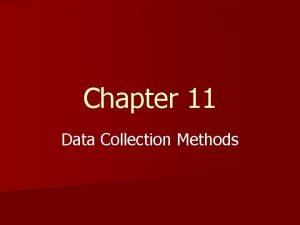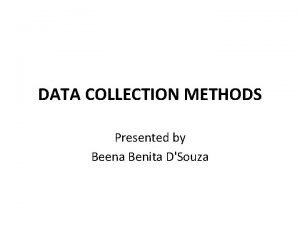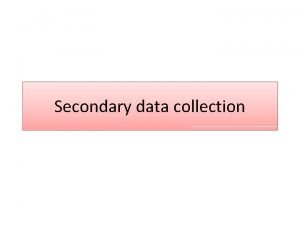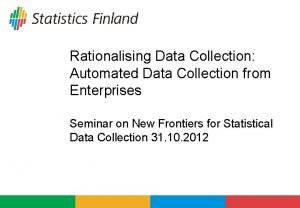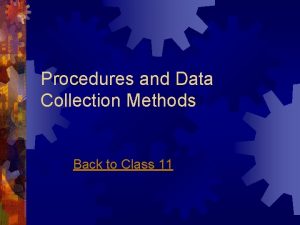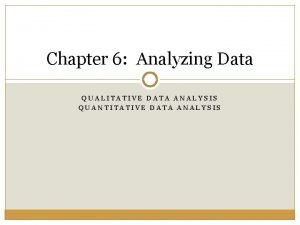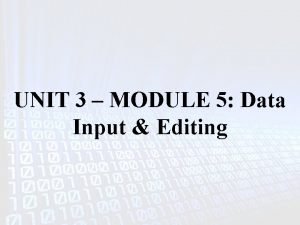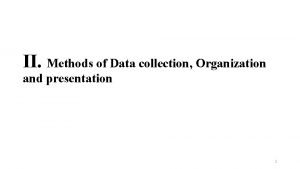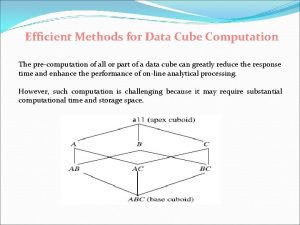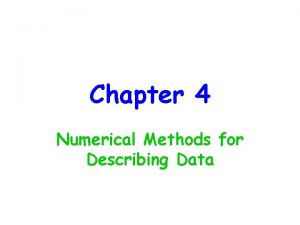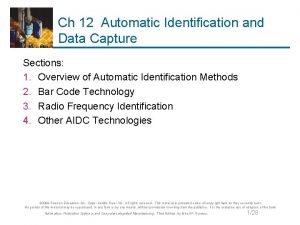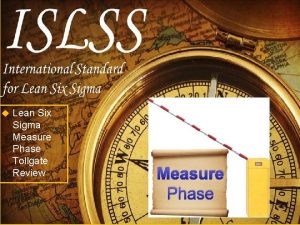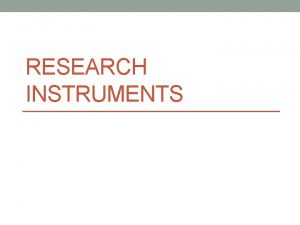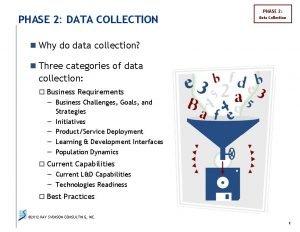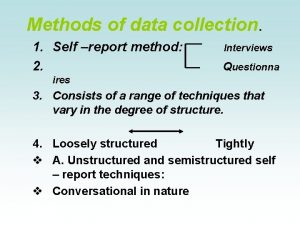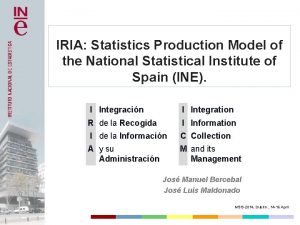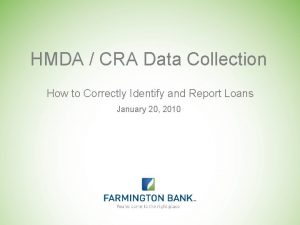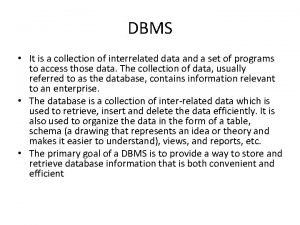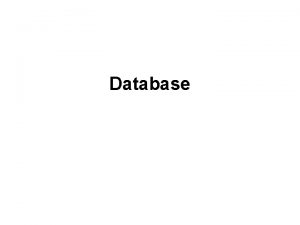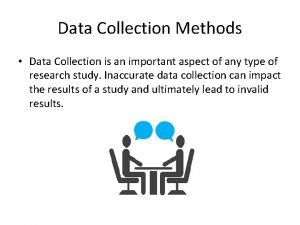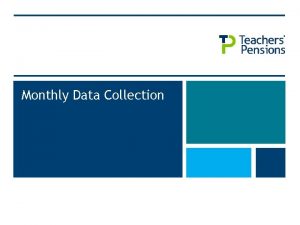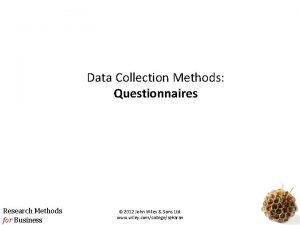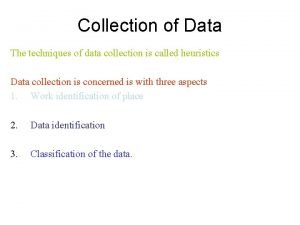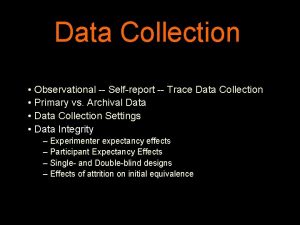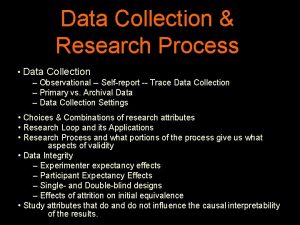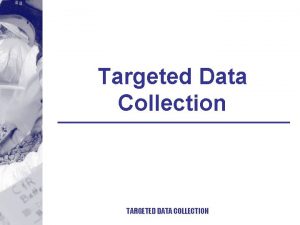UNIT II DATA COLLECTION Methods of Data collection


















































- Slides: 50

UNIT II DATA COLLECTION

Methods of Data collection Data constitute the foundation of any scientific analysis and interpretation. There is a subtle difference between data and information. While data are just facts or recorded measures of certain phenomena, information refer to a body of facts in a format that facilities decision making or in a context that defines relationship between pieces of data. Data can be obtained from two important sources viz. (i) secondary source and (ii) primary source

Secondary data When an investigator (the student researcher) uses the data which have already been collected by others, such data are called secondary data. show tableno. 8. 1 on chapter 8

Primary Data Primary data are collected directly by the researcher from the original sources. In primary data collection the researcher can collect the required data according to his research needs. He can collect them when he wants them and in the form he needs them. Primary data collection is costly and timeconsuming.

Tools for data collection The various methods of data collection involve the use of appropriate tools or instruments. These tools / instruments facilitate data collection

a. ) Schedule: It is a proforma containing a set of questions which are asked and filled in by an interviewer personally [face-to-face] � i. Observation schedule or observationnaire - This is a form used to record the observations - The items to be observed are determined in advance and grouped into appropriate categories - The items are structured with possible alternatives Space is provided against each unit observation

ii. Interview guide It is used for non-directive and depth interviews It contains only the broad topics or areas to be covered in the interview It serves as a suggestive reference or prompter during interview It aids in focusing attention on salient points relating to the study It helps in securing comparable data in different interviews by the same or different interviewers

iii. Interview schedule and mailed questionnaire Both these tools are widely used in surveys Both contain lists of questions to be answered by the respondents While schedule is filled out by the interviewer, questionnaire is completed by the respondent

b. ) Opinionaire It is similar to interview schedule / mailed questionnaire. It is used for studying opinions of people. Wording of statements may differ.

c. ) Inventory It is essentially a list that the respondent is asked to mark or check in a particular way regarding personal qualities.

QUESTIONNAIRE OR SCHEDULE A questionnaire / schedule should have provision to collect personal information of the respondents apart from the information on the study under reference. The personal information generally pertain to (i) Gender (ii) Age group (iii) Marital status (iv) Educational background (v) Occupation (vi) Salary / Income (vii) Experience and etc. , depending on the nature of study. This information is essential to differentiate the opinion based on gender, age, income and etc of the respondents.

The questions included may be open-ended, closed-end questions, dichotomous, multiplechoice questions or declarative. i. Open-ended questions: These are unstructured ones providing free scope to the respondents to reply with their own choice of words and ideas. (e. g. ) What is your opinion on the present trend in HR? What are your comments on the Govt. initiatives in improving FDI?

ii. Closed-end questions: These are structured ones with two or more alternative responses for the respondent to choose. They generally contain standardized answers. They are simple to administer and easy to compile and analyse. As the alternatives are designed with reference to the requirements of the study, the chances of securing relevant answers are better.

iii. Dichotomous or two-choice questions: A dichotomous question can be answered either as ‘yes’ or ‘no’. Here, there is no choice for the respondent to say ‘undecided’, ‘do not know’, ‘sometimes’ or ‘partially’. iv. Multiple choice questions: � These questions contain more than 2 alternatives (e. g. ) Why do you prefer a particular brand of mobile handset? Price is reasonable Handy Sleek More features Others ( please specify)

Designing a self-completion questionnaire 1. 2. 3. 4. The questionnaire must be designed in such a way that respondents answer the questions willingly and with ease. Avoiding cramping of presentation: Presenting clearly: Arranging fixed answers: The desirable format is vertical as shown below: 1. 2. 3. 4. 5. Very good Good Fair Poor Very poor - 5 4 3 2 1

5. In the vertical format not only is there less ambiguity about where tick is placed, the coding is easier. 6. Horizontal format as shown below is not desirable. Very Good-Fair-Poor-Very Poor-5 4 3 2 1. 7. Giving clear instructions: The instructions must be clear whether the respondents are to place a tick or circle or underline the appropriate answer

Questionnaire vs Schedule The main differences between questionnaire and schedule in collecting data/ information are given in table § Show table 8. 3 in chapter 8

Characteristics of a good questionnaire Relevance: The questions must be relevant to the research problem being investigated Questions must be short and simple The number of questions must be as few as possible Questions should be logically arranged: To elicit a natural and spontaneous reply, the questions are arranged in a logical sequence. For example, asking a woman respondent how many children she has before knowing whether she is married or not is undesirable. Questions should be capable of getting objective answers: Depending on the type of study the questions can be dichotomous or multiple choice. Open-ended or free answer questions must be placed at the end. Cross checks: One or more questions may be repeated in different formats to cross-check whether the respondent answers the questions sincerely and carefully. General Questions: The question must be specific. (eg) instead of asking ‘how well did you like the book’ it could be ‘did you recommenced the book to others’ or ‘Did you look for other books by that author? ’

Questions to be avoided: Questions requiring calculations Questions requiring memory Questions of sensitive nature. Unrelated area Leading questions Loaded questions: A ‘loaded’ question is one that contains words which are emotionally charged and suggests an automatic feeling of the approval. e. g. Should not the terrorists be hanged on the spot? Ambiguous questions: These are the questions which do not convey clear meaning. e. g. Do you prefer a small or a big house? How small is ‘small’ or how big is ‘big’ depends on the social status of the respondent. Double-barreled questions: These questions contain two or more different ideas / suggestions / references. e. g. Do you favour or oppose ‘increased job security’ and ‘productivity-linked’ wage system? Long questions: Long, complex or compound questions may be ambiguous or confusing

Processing of Data The important steps in data processing are 1. 2. 3. 4. Identifying the types of information Editing the data Coding of data in the case of large volume of data and where secrecy is to be maintained Classifying and tabulation of data

i. Identifying the types of information: The information collected is identified whether they are quantitative and qualitative in nature. All the qualitative information is converted into quantitative data. For instance, the opinion collected in respect of overall job satisfaction of employees on a 5 -point Likert type scale is quantified appropriately (Strongly Agree gets 5 points, Agree 4 points, No idea 3 points, Disagree 2 points and Strongly Disagree 1 point).

ii. Editing: Editing is done to make the data ready for coding and transfer to data storage. Editing is done the identify the errors and correct them. Editing is mainly done to check for completeness, accuracy and uniformity.

iii. Coding of Data: Coding involves assigning numbers or other symbols to answers so that the responses can be grouped note a limited no of categories. (e. g. ) Gender: Male many be codified as M or 1 and Female as F or 2 Occupation: Salaried as S or 1 Business as B or 2 Professional as P or 3 Retired as R or 4 Others as O or 5 Categorization of data must be � � appropriate to the research problem / purpose exhaustive mutually exclusive and derived from one classification dimension

iv. Classification and Tabulation: Tabulation is the process of summarizing raw data into meaningful categories and presenting them for a quick understanding. Tabulation is a pre-requisite for statistical analysis.

Components of a table: 1. 2. 3. 4. 5. Heading - Table number, title of the table and designation of units Body – Stub-head – headings of all rows or blocks of sub-items Body head – headings of all columns or main captions and sub-captions Field /Body – cells in rows and columns Notations - foot notes and sources wherever applicable.

Example of a Table Example: Respondents’ response to a particular question. Have you ever visited Brookefields in Coimbatore? If the respondents in the above example are classified based on the gender and their response it becomes a 2 x 2 contingency table Gender Frequency (visit to Brookfields) Total Yes No Male 361 31 392 Female 15 93 108

MEASUREMENT AND SCALING MEASUREMENT Measurement is defined as assignment of numerals to objects / events according to rules or to represent amounts or degrees of a property possessed by all of the objects.

Levels of Measurement Levels Characteristics Utility Nominal No order, distance or origin Determination of equality Ordinal Order but no distance or origin Determination of less than or more than value Interval Both order and distance but no origin Determination of equality of intervals / differences Ratio Order, distance and origin Determination of equality of ratios

(i). Nominal measurement: It is a scale in which the numbers or letters assigned to objects serve as labels for identification or classification. It is the simplest and lowest level of measurement It includes the classification of variables into several subclasses by assigning numerals or any other symbols to mutually exclusive sub classes. For example, gender is classified into male and female and the numeral 1 may be assigned to male and 2 to female. In the case of religion, Hindus may be assigned the numeral 1, Muslims 2, Christians 3, Sikhs 4, Jains 5 and others 6. Here, the numerals 1, 2, 3 etc are just labels and have no quantitative value. It indicates no order or distance relationship and has

(ii). Ordinal measurement It is a scale that arranges objects or alternatives according to their magnitudes. In this measurement, objects/persons are placed in order by assigning ranks in ascending or descending order as 1 st, 2 nd, 3 rd and etc. .

(iii). Interval measurement It is a scale that arranges objects or alternatives according to their magnitudes and also differentiates this ordered arrangement in units of equal interval. In addition to the features of nominal and ordinal levels, interval measurement has the concept of equality of interval

(iv). Ratio Measurement: It is a scale having absolute rather than relative quantities and possessing an absolute zero. This is the highest and most ideal level of measurement. Foot-scale is the typical example. Those properties which have natural or absolute zero, such as weight, height, distance, area, money value, population, rate of return and etc can be measured.

Scaling (Attitude Scaling) Scaling is a branch of measurement that involves construction of an instrument that associates qualitative constructs with quantitative metric units. Scaling is evolved out of efforts in psychology and education to measure unmeasurable constructs such as self-esteem, motivation, leadership etc. , It is a procedure to assign numbers (or symbols) to a property of objects to impart some of the characteristics of numbers to the properties in question.

Scaling Techniques To measure concepts, attitudes or opinions questioning is a widely used method. When a manager is asked his views on a particular employee, the response could be ‘a good worker’, ‘a troublemaker’, ‘a union activist’, ‘reliable’, ‘a fast worker’ or ‘always a latecomer’. But this type of response is of limited value to the researcher. To improve the usefulness of such replies quantification is necessary. To quantify dimensions that are essentially qualitative rating scales or ranking sales are used.

Rating scales Rating scales are used to judge properties of objects without reference to other similar objects. The ratings may be ‘like-dislike’, ‘good average-bad’, ‘always – often –sometimes rarely’ or ‘strongly agree – agree - no idea disagree or strongly disagree’. There is no conclusive support for choosing a three-point scale over scales with five or more points. The most widely used scales range from three to seven points.

(a) Simple category scale: This scale has two response choices. The choices could be ‘yes’ or ‘no’, ‘important’ or ‘unimportant’, ‘agree’ or ‘disagree’ and etc. This produces nominal data (e. g. ) ‘I plan to join only a premier management institute” : Say ‘Yes’ or ‘No’.

(b) Category scale: It is an attitude scale consisting of several response categories to provide the respondent with alternative ratings. Example: How often is your manager friendly? very often – sometims – rarely – never. Some of the category scale are : Quality: Excellent – Good – Fair – Poor. Importance: Very Important – Fairly important – Neutral – Not so important – Not at all important Satisfaction: Very satisfied – Somewhat Satisfied – Not at all satisfied

(c) Multiple choices – Single response scale: This scale is appropriate when there are multiple options available for the respondent and only one answer is sought. (e. g). “which magazine do you read often for business news? ” Tick (√) any one Business India. Business Today Business Week Business World Business Standard Other (Specify)

(d) Multiple choice – multiple response scale: As a variation of the above scale, this scale allows the respondent to select one or several alternatives. (e. g). Check any of the following books you consulted to prepare for Organizational Behaviour examination. O. B. By Fred Luthans O. B. By Kieth Davis O. B. By Stephen. P. Robbins O. B. By Mc. Shane O. B. By L M Prasad Other (Specify).

(e) Likert Scale: It is a measure of attitudes designed to allow respondents to indicate how strongly that agree or disagree with carefully constructed statements that range from very positive to very negative. (e. g. ) “Assignment is the best way of measuring management students’ potential” Strongly Agree 5 Agree 4 No Idea 3 Disagree 2 Strongly Agree 1

(f) Semantic differential scale: It is an attitude measure consisting of a series of seven-point bipolar rating scales allowing responses to a concept. This scale measures the psychological meanings of an attitude. (e. g). The semantic differential scale items for analyzing candidates for leadership position are shown below: Successful 3 2 1 0 -1 -2 -3 Unsuccessful Progressive 3 2 1 0 -1 -2 -3 Regressive Strong Active passive Fast 3 True 3 Sociable 3 3 3 2 2 2 1 1 1 2 2 0 0 0 1 1 0 0 -1 -1 -1 -2 -2 -3 -3 Weak -2 -2 -2 -3 -3 -3 Slow False Unsociable

(g) Numerical Scales: This scale is similar to semantic differential scale except that it uses numbers instead of verbal descriptions as response options to identify response positions. They have equal intervals. The extreme points are labeled by verbal anchors. Numeric scales are often 5 point scales. (e. g). Performance appraisal can be done on a Numerical scale. Extremely Favorable 5 4 3 2 1 Extremely Unfavorable

(h) Multiple rating lists: It is similar to numerical scale, but differs in two aspects; one, it accepts a circled response from the respondent and second the layout allows visualization of the results. e. g. To find out the relative importance of the various characteristics of the after-sales service of a two-wheeler manufacturer the scale could be as follows: “Please indicate how important or unimportant each service characteristic is” Fast and reliable repair Important 7 6 5 4 3 2 1 Unimportant Service at customers’ place Important 7 6 5 4 3 2 1 Unimportant Knowledge and skill of technicians Important 7 6 5 4 3 2 1 Unimportant Genuineness of spares Important Repair charges Unimportant 7 6 Important 5 4 3 7 6 2 5 1 Unimportant 4 3 2 1

(i) Fixed or Constant Sum Scale: It is a measure of attitude in which respondents are asked to divide a constant sum to indicate the relative importance of attitude. e. g. Preference given to various dimensions of a product (body spray) by a respondent Price Brand Size Smell Shape Total 30% 15% 30% 10% 5% 100%

(k) Graphic Rating Scale: This scale consists of a graphic continuum that allows respondents to rate an object by choosing any point on the continuum. (e. g. ) “How likely are you to recommend your College/Institute to others seeking admission for MBA programs? ” Very Likely I-----------------------I Very Unlikely Putting an ‘X’ at any position along the line reflects the respondent’s suggestion. Example of graphic scale stressing visual communication. “How was the lunch? ” The response is indicated by putting an ‘X’ along the line.

Ranking scales In ranking scales, the respondent directly compares two or more objects and makes choices among them.

a. Simple ranking: Respondents often rank order their preferences from most preferred to least preferred. It is not difficult for respondents to understand the task of rank ordering the importance of things such as fringe benefits, social security measures, financial incentives etc. The problem is when the no. of items increases, ranking is different.

b. Paired-comparison scale: In this scale the respondent can express attitudes/opinions unambiguously by choosing between two objects. The number of judgements required in paired comparison is n(n-1) / 2 where ‘n’ is the number of objects or stimuli.

c. Forced Ranking Scale: In this scale the respondents are asked to rank the attributes / objects relative to each other. For instance, if the marketing researcher desires to know which attribute is to be given preference to a new car model he may ask the consumers to rank the attributes such as price, safety, style, colour, mileage, size and etc relative to each other attribute.

d. Comparative Scale: In this scale the respondents are required to compare the items/objects/stimuli against a standard. Suppose the Principal of a college wants to compare his college with others he may ask the PG students to compare with their previous college the ambience of the present college as superior –same– inferior.
 Types of data collection methods
Types of data collection methods Legal analysis methods
Legal analysis methods Observational data collection method
Observational data collection method Observation methods of data collection
Observation methods of data collection What is primary data.
What is primary data. Automated data collection methods
Automated data collection methods Fabrication of wax pattern
Fabrication of wax pattern Collection methods and procedures
Collection methods and procedures Unit 6 review questions
Unit 6 review questions Landsat collection 1 vs collection 2
Landsat collection 1 vs collection 2 Documents against payment
Documents against payment Research procedure in methodology
Research procedure in methodology Data collection secondary data sources
Data collection secondary data sources Mobile dispensing unit in hospital
Mobile dispensing unit in hospital Collection unit 4
Collection unit 4 Data capture techniques
Data capture techniques Data analysis methods
Data analysis methods Automatic data capture methods
Automatic data capture methods Design of output
Design of output Methods of gathering data national 5 pe
Methods of gathering data national 5 pe Data input methods
Data input methods Data collection organization and presentation
Data collection organization and presentation Data cube computation
Data cube computation Methods to avoid false discoveries in data mining
Methods to avoid false discoveries in data mining Numerical methods for describing data
Numerical methods for describing data Error detection methods in data link layer
Error detection methods in data link layer Automatic data capture methods
Automatic data capture methods Binning in data mining
Binning in data mining Quality control definition
Quality control definition Methods of gathering data higher pe
Methods of gathering data higher pe Qualitative and quantitative data analysis
Qualitative and quantitative data analysis Tollgate review
Tollgate review Priority improvement areas sample
Priority improvement areas sample Finding answers through data collection
Finding answers through data collection Sampoorna school code
Sampoorna school code Data collection research proposal
Data collection research proposal Instruments in research methodology
Instruments in research methodology What is data gathering instrument
What is data gathering instrument Define data collection method
Define data collection method Data collection phase
Data collection phase Encyclopedia
Encyclopedia Interview method of data collection
Interview method of data collection Self report method
Self report method Www iria ine es
Www iria ine es Network data collection at slac
Network data collection at slac Cawi data collection
Cawi data collection Hmda & cra data integrity reviews
Hmda & cra data integrity reviews Data collection plan
Data collection plan A dbms is a collection of interrelated data and
A dbms is a collection of interrelated data and Interview method of data collection
Interview method of data collection A structured collection of data
A structured collection of data


